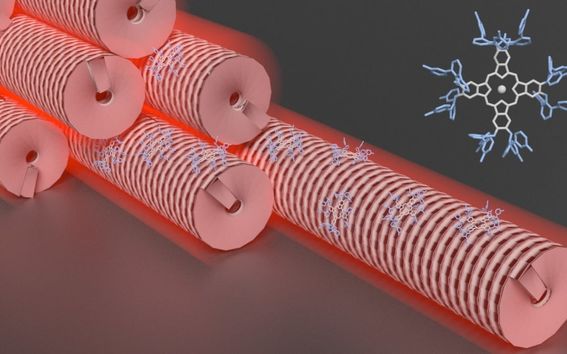Dyes and viruses create new composite material for photooxidation reactions

A research team from Aalto University has developed a novel strategy to create virus-based materials for catalysis. The project, which is framed within the Horizon 2020 Marie Skłodowska-Curie actions, aims to pave the way towards the application of optically active biohybrid materials – a combination of biomolecules and synthetic moieties – in topics ranging from nanomedicine to green organic synthesis or environmental sciences.
‘Our first challenge was to select the right photosensitizer,’ says Eduardo Anaya, Postdoctoral Researcher at Aalto University, ‘We decided to employ phthalocyanines, a synthetic derivative of hematoporphyrin (the dye responsible for the colour of blood), due to their outstanding properties as a reactive oxygen species generator. However, the use of this kind of dyes in aqueous media presents several challenges that affect their performance. Therefore, careful design was necessary to maintain their properties`.
In collaboration with Professor Tomas Torres’ research group from the Universidad Autonoma de Madrid, a new phthalocyanine derivative was synthesised, resulting in a molecule with resilient properties in different ionic strength media. The design ensured the photoactivity of the dye even in an aqueous environment.
‘One of the focuses of our research group lies in the design of new protein assemblies and their potential application as new materials’ adds Professor Mauri Kostiainen, leader of the Biohybrid Materials group. ‘Our approach is based on supramolecular interactions, such as electrostatic binding so, in this project, we decided to combine the positively charged dye with a negatively charged tobacco mosaic virus (a 300 nm long rod-like virus), resulting in a photoactive fibrous material. This approach led to highly ordered threads, which were thoroughly characterised by X-ray scattering and several microscopy techniques in the Nanomicroscopy Center at Aalto’, Kostiainen says.
In addition to the structural characterisation,Anaya points out that the most crucial feature is that the dye remains active despite being immobilised in the fibres. ´We can fix the reaction site in solid support and pass the solution we want to react through it, being visible light the only “fuel” we use for it to happen. This allows us to create a continuous flow set-up that enable the scaling up of the oxidation process’, he concludes.
The research team designed a proof-of-concept device where immobilising the fibres within a glass capillary; an incoming flow was oxidised in several cycles. The resilience of the fibres was assessed, concluding that both their structural stability and photoactivity remain constant over time. One additional advantage is that, once the oxidation process is completed, a light pulse can disassemble the fibres, making them easy to dispose of. The reported approach represents the first step towards the use of biohybrids in continuous flow reactions, which represent an environmentally friendly approach to this type of industrial process.
The results were published in Advanced Materials, 08 August 2019
Article: Eduardo Anaya-Plaza et al. “Phthalocyanine-Virus Nanofibers as Heterogeneous Catalysts for Continuous-Flow Photooxidation Processes”, 2019, DOI: 10.1002/adma.201902582
More information:
Dr Eduardo Anaya-Plaza (@anayaplaza)
Postdoctoral Researcher
Biohybrid Materials Group, Aalto University School of Chemical Engineering, Finland
Tel: +358 505910322
Email: [email protected]
This research has been funded by the European Union’s Horizon 2020 research and innovation programme under the Marie Sklodowska-Curie grant agreement No 794536.
- Published:
- Updated:
Read more news

The City of Espoo and Aalto University signed a strategic agreement for a new five-year partnership period
The collaboration includes investments in the Otaniemi area, business and innovation activities, and efforts to integrate international talent.From coffee rooms to big crowds – Discussion is important in developing new lifewide learning content in Aalto
Craig Carlson is developing educational content for the target audience of lifewide learning, such as adult learners in working life.